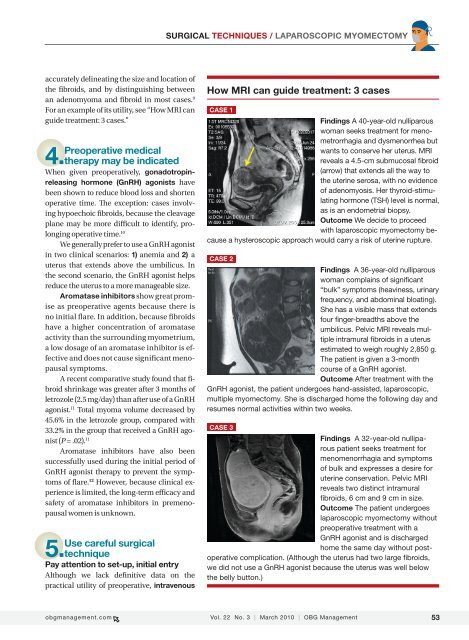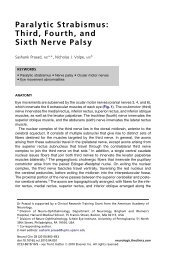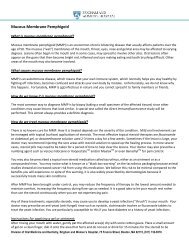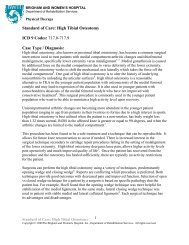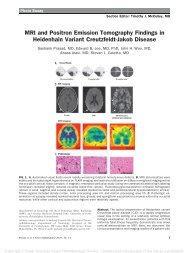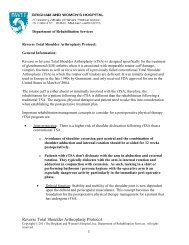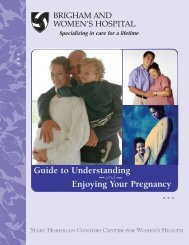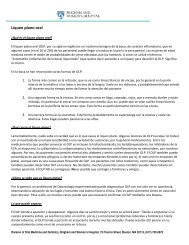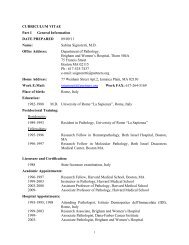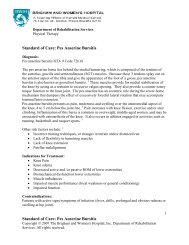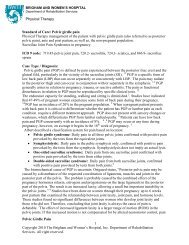Laparoscopic Myomectomy - Brigham and Women's Hospital
Laparoscopic Myomectomy - Brigham and Women's Hospital
Laparoscopic Myomectomy - Brigham and Women's Hospital
You also want an ePaper? Increase the reach of your titles
YUMPU automatically turns print PDFs into web optimized ePapers that Google loves.
accurately delineating the size <strong>and</strong> location of<br />
the fibroids, <strong>and</strong> by distinguishing between<br />
an adenomyoma <strong>and</strong> fibroid in most cases. 9<br />
For an example of its utility, see “How MRI can<br />
guide treatment: 3 cases.”<br />
Preoperative medical<br />
4. therapy may be indicated<br />
When given preoperatively, gonadotropinreleasing<br />
hormone (GnRH) agonists have<br />
been shown to reduce blood loss <strong>and</strong> shorten<br />
operative time. The exception: cases involving<br />
hypoechoic fibroids, because the cleavage<br />
plane may be more difficult to identify, prolonging<br />
operative time. 10<br />
We generally prefer to use a GnRH agonist<br />
in two clinical scenarios: 1) anemia <strong>and</strong> 2) a<br />
uterus that extends above the umbilicus. In<br />
the second scenario, the GnRH agonist helps<br />
reduce the uterus to a more manageable size.<br />
Aromatase inhibitors show great promise<br />
as preoperative agents because there is<br />
no initial flare. In addition, because fibroids<br />
have a higher concentration of aromatase<br />
activity than the surrounding myometrium,<br />
a low dosage of an aromatase inhibitor is effective<br />
<strong>and</strong> does not cause significant menopausal<br />
symptoms.<br />
A recent comparative study found that fibroid<br />
shrinkage was greater after 3 months of<br />
letrozole (2.5 mg/day) than after use of a GnRH<br />
agonist. 11 Total myoma volume decreased by<br />
45.6% in the letrozole group, compared with<br />
33.2% in the group that received a GnRH agonist<br />
(P = .02). 11<br />
Aromatase inhibitors have also been<br />
successfully used during the initial period of<br />
GnRH agonist therapy to prevent the symptoms<br />
of flare. 12 However, because clinical experience<br />
is limited, the long-term efficacy <strong>and</strong><br />
safety of aromatase inhibitors in premenopausal<br />
women is unknown.<br />
Use careful surgical<br />
5. technique<br />
Pay attention to set-up, initial entry<br />
Although we lack definitive data on the<br />
practical utility of preoperative, intravenous<br />
SURGICAL TECHNIQUES / LAPAROSCOPIC MYOMECTOMY<br />
How MRI can guide treatment: 3 cases<br />
CASE 1<br />
Findings A 40-year-old nulliparous<br />
woman seeks treatment for menometrorrhagia<br />
<strong>and</strong> dysmenorrhea but<br />
wants to conserve her uterus. MRI<br />
reveals a 4.5-cm submucosal fibroid<br />
(arrow) that extends all the way to<br />
the uterine serosa, with no evidence<br />
of adenomyosis. Her thyroid-stimulating<br />
hormone (TSH) level is normal,<br />
as is an endometrial biopsy.<br />
Outcome We decide to proceed<br />
with laparoscopic myomectomy because<br />
a hysteroscopic approach would carry a risk of uterine rupture.<br />
CASE 2<br />
Findings A 36-year-old nulliparous<br />
woman complains of significant<br />
“bulk” symptoms (heaviness, urinary<br />
frequency, <strong>and</strong> abdominal bloating).<br />
She has a visible mass that extends<br />
four finger-breadths above the<br />
umbilicus. Pelvic MRI reveals multiple<br />
intramural fibroids in a uterus<br />
estimated to weigh roughly 2,850 g.<br />
The patient is given a 3-month<br />
course of a GnRH agonist.<br />
Outcome After treatment with the<br />
GnRH agonist, the patient undergoes h<strong>and</strong>-assisted, laparoscopic,<br />
multiple myomectomy. She is discharged home the following day <strong>and</strong><br />
resumes normal activities within two weeks.<br />
CASE 3<br />
Findings A 32-year-old nulliparous<br />
patient seeks treatment for<br />
menomenorrhagia <strong>and</strong> symptoms<br />
of bulk <strong>and</strong> expresses a desire for<br />
uterine conservation. Pelvic MRI<br />
reveals two distinct intramural<br />
fibroids, 6 cm <strong>and</strong> 9 cm in size.<br />
Outcome The patient undergoes<br />
laparoscopic myomectomy without<br />
preoperative treatment with a<br />
GnRH agonist <strong>and</strong> is discharged<br />
home the same day without postoperative<br />
complication. (Although the uterus had two large fibroids,<br />
we did not use a GnRH agonist because the uterus was well below<br />
the belly button.)<br />
obgmanagement.com Vol. 22 No. 3 | March 2010 | OBG Management 53


